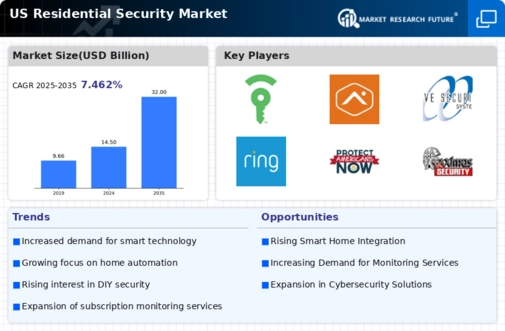The US Residential Security Market is characterized by a dynamic and competitive landscape, driven by the increasing demand for home automation and security solutions. With the rise of smart technology, a broad array of companies have entered this intriguing field, introducing innovative products and services aimed at improving residential safety and convenience. The market is shaped by advancements in technology, changing consumer preferences, and regulatory considerations. A thorough understanding of the competitive insights within this sector requires examining the key players, their strategies, and how they adapt to evolving market conditions, including partnerships and collaborations that enhance service offerings.
As customer expectations rise, companies are compelled to differentiate their services through technology, customer support, and value proposition, making competitive intelligence crucial for sustained growth.Frontpoint stands out within the US Residential Security Market due to its strong commitment to customer service and its effective use of technology.
The company has built a reputation on providing reliable equipment and professional monitoring services that prioritize consumer safety and satisfaction. Frontpoint's strengths lie in its user-friendly installation processes, interactive mobile applications, and flexibility in service plans that cater to various customer needs. The company's dedication to quality allows it to foster long-term relationships with its customers and maintain a favorable position in the market. Its reputation is further bolstered by positive customer reviews and strong word-of-mouth recommendations, facilitating organic growth.
By focusing on these strengths, Frontpoint continues to solidify its presence in the competitive landscape of the US Residential Security Market.Alarm.com plays a prominent role in the US Residential Security Market, providing a wide range of smart home and security solutions designed for both residential and commercial applications. The company specializes in services such as remote monitoring, video surveillance, and automated home controls, positioning itself as a leader in integrating security with home automation. Alarm.com’s strategic focus on innovation is evident through its regular updates and feature enhancements, helping it stay ahead of competitors.
Its market presence is amplified through partnerships with various security dealers and service providers, enabling broader distribution of its technology across the nation. Additionally, Alarm.com has engaged in strategic mergers and acquisitions to enhance its technological capabilities and expand its service portfolio, further solidifying its competitive stance. The company’s strengths are reflected in its robust infrastructure and commitment to providing comprehensive customer support, making it a trusted choice for consumers seeking effective residential security solutions in the US.




















